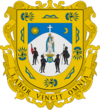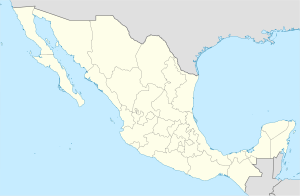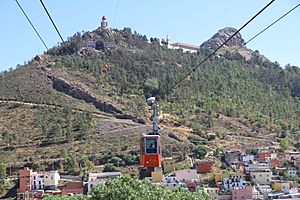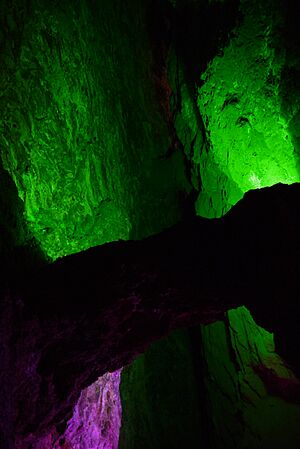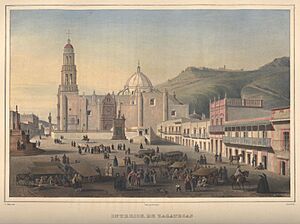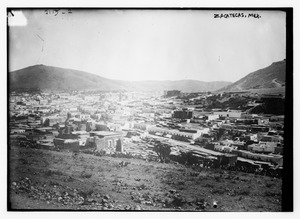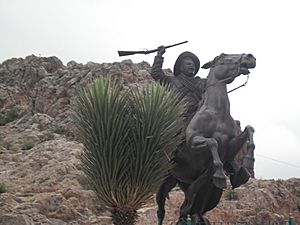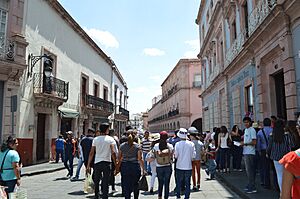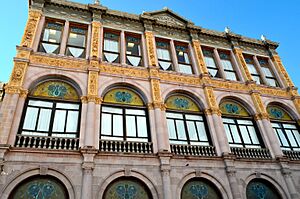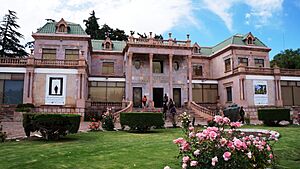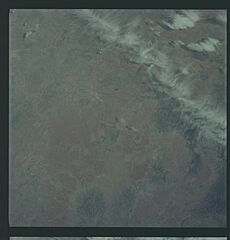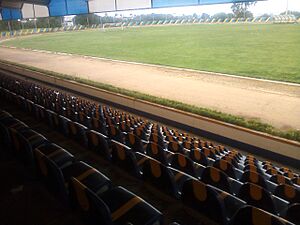Zacatecas (city) facts for kids
Quick facts for kids
Zacatecas
|
||
|---|---|---|
|
City and municipality
|
||
|
Cathedral of Zacatecas and main street
Miguel Auza Square
Quinta Real and aqueduct
Francisco Goitia Museum
St. Francis Monastery (now Rafael Coronel Museum)
El Edén Mine
Church of Our Lady of Fatima
|
||
|
||
| Nickname(s):
Civilizadora del Norte
Ciudad de Cantera Corazón de Plata |
||
| Country | Mexico | |
| State | Zacatecas | |
| Founded | 1548 | |
| Municipal Status | 1825 | |
| Area | ||
| • Municipality | 356.14 km2 (137.51 sq mi) | |
| Elevation
(of seat)
|
2,440 m (8,010 ft) | |
| Population
(2020)
|
||
| • Municipality | 138,444 | |
| • Density | 388.735/km2 (1,006.818/sq mi) | |
| Time zone | UTC−6 (CST) | |
| • Summer (DST) | UTC−5 (CDT) | |
| Postal code (of seat) |
98000
|
|
| Area code(s) | 492 | |
| Website | /Official site: http://www.capitalzacatecas.gob.mx/ | |
| Official name: Historic Centre of Zacatecas | ||
| Type: | Cultural | |
| Criteria: | II, IV | |
| Designated: | 1993 (17th session) | |
| Reference #: | 676 | |
| Region: | Latin America and the Caribbean | |
Zacatecas is a major city and the capital of the state of Zacatecas in north-central Mexico. It started as a Spanish mining camp in the mid-1500s. Native Americans already knew about the area's rich silver and other minerals. Because of the valuable mines, Zacatecas quickly became one of the most important mining cities in New Spain.
The city saw many battles in the 1800s. A big event was the Battle of Zacatecas during the Mexican Revolution. Here, Francisco Villa and his forces captured the town. This event is still celebrated today.
Today, the old part of the city is a World Heritage Site. This is because of its beautiful Baroque buildings from its mining past. Mining is still a key industry here. The name Zacatecas comes from the Zacateco people and means "people of the grasslands" in Nahuatl.
Contents
History of Zacatecas
Early People in Zacatecas
The first people arrived in this area about 10,000 years ago. At that time, the climate was different, with more plants and animals. Later, Chichimeca tribes like the Caxcans, Guachichils, Guamares, Huichols, and Zacatecos lived here. The Zacatecos were the most common in the area where the city is now. These tribes were already mining silver and other metals from the hills long before Europeans came. This made the area important even before Columbus.
Zacatecas During Colonial Times
The Spanish explorers reached Zacatecas from Guadalajara. In 1540, Nuño de Guzmán traveled from Mexico City, taking over lands that are now the states of Michoacán and Jalisco. One of his leaders, Cristóbal de Oñate, conquered the area near Guadalajara. Another, Pedro Almindes Chirinos Peralmindes, explored north and took Zacatecas easily. However, he did not know about the riches hidden underground.
Later, in 1546, Juan de Tolosa brought back rock samples from Cerro de la Bufa. These rocks had a lot of silver and lead. Soon, a mining camp was set up at the foot of Cerro de la Bufa. The Zacatecos fought against the Spanish staying there, but the Spanish wanted the silver. They defeated the native people in the 1540s. More explorations found other rich hills nearby.
A military mining camp officially started in 1548. It was called Minas de Nuestra Señora de Remedios. The first big silver vein was found in 1548 in a mine called San Bernabé. More discoveries followed in mines like Albarrada de San Benito and Vetagrande. This brought many people to Zacatecas, including craftspeople, merchants, and religious leaders. In 1550, Leonor Cortés Moctezuma, the daughter of Hernán Cortés, came to Zacatecas. She married Juan de Tolosa.
The settlement quickly grew into one of the most important cities in New Spain, second only to Mexico City. The camp became a church area in 1550. In 1585, it was named a city: "Muy Noble y Leal Ciudad de Nuestra Señora de Zacatecas." It received its special symbol (coat of arms) from Philip II of Spain. The successful mines led to many indigenous people and enslaved Africans working there.

The city grew along the Arroyo de la Plata, which is now Hidalgo Avenue, the main road. Tall buildings were built because there was little flat land. The first house was built in 1547. Hospitals were built in the 1550s. Zacatecas became one of the richest states in Mexico. The El Edén mine, which started in 1586, was very important. It produced gold and silver, mostly in the 1600s and 1700s. This mine is now inside the city and closed for mining in 1960. It reopened as a tourist spot in 1975.
By the end of the 1500s, Zacatecas was the second most important city in New Spain. The money from its mines made Spain very powerful in Europe. It was also a key center for spreading Christianity. Religious groups like the Franciscans (1558), Augustinians (1576), and Dominicans (1604) set up monasteries here. Many missionary trips to places like California and Texas started from Zacatecas.
Over the colonial period, the wealth from the mines paid for many important buildings. Most of these were built in the 1700s. One example is the Colegio de San Luis Gonzaga, founded in 1796.
Mexican Independence and the 1800s
Ignacio López Rayón led Mexican rebels to capture Zacatecas on April 15, 1811. This was early in the fight for Mexico's independence from Spain. After Mexico became independent, Zacatecas city became the capital of the new state.
In the mid-1820s, the city saw the start of its first opera house, teachers' college, and state treasury. The first newspaper in the state began in 1825. The city became a municipality in 1825.
For most of the 1800s, different political groups fought for control of Zacatecas. In 1835, Antonio López de Santa Anna defeated local forces. During the Reform War, the city was taken by general Miguel Miramón. The first railroad connecting Zacatecas to Guadalupe was finished in 1880. By 1884, trains connected Zacatecas to Mexico City and El Paso.
The Mexican Revolution in Zacatecas
During the Mexican Revolution, Zacatecas was the site of a huge battle in 1914. Rebel forces led by Francisco Villa fought against the government forces of Victoriano Huerta. Zacatecas was Huerta's last strong point. Villa's army, the División del Norte, arrived on June 19, 1914.
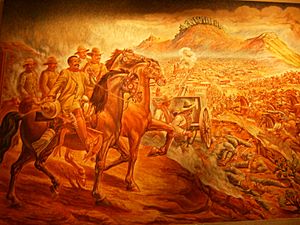
Taking the city would open the way for Villa to reach Mexico City. Villa's forces were led by General Felipe Ángeles. The battle started at 10:00 a.m. on June 23 with rebel cannons firing. Over 22,000 rebel troops attacked the city from four directions. The battle lasted until about 5:00 p.m., when Huerta's troops gave up. Villa's army took the important hills of La Bufa and El Grillo and entered the city. The rebels took things from the city and destroyed some buildings. About 5,000 government soldiers and 3,000 rebels were hurt or died.
After the Mexican Revolution, Zacatecas decided to use its original city symbol from Philip II again. It became the symbol for both the city and the state. The "Marcha Zacatecas" song, written by Genaro Codina, became the unofficial song of the city and state.
Zacatecas in the 1900s
The old Instituto de Ciencias became the Universidad Autónoma de Zacatecas in 1968. An international airport was built in 1970.
The city's anniversary used to be celebrated on the day of the Virgin of Zapopan. In 1975, the patron saint changed to the Virgin del Patrocinio, celebrated on the same day.
The city center was named a World Heritage Site in 1993. UNESCO said it was because Zacatecas was founded in 1546 after silver was found. It grew rich in the 1500s and 1600s. The city is built on steep slopes with great views. It has many old religious and civil buildings. The cathedral, built from 1730 to 1760, stands out. It is known for its beautiful design and rich Baroque style. It mixes European and local decorations.
Zacatecas has had several earthquakes. The last one was in 1995 and caused only small damage.
Zacatecas in the 2000s
In 2009, the city council approved a new logo for the city. It included the image of the Virgin of Zacatecas. However, some people said this logo went against the state's constitution. They also disliked that the logo used the colors of the mayor's political party.
The city has grown a lot. Some houses are now built on the edge of a creek or on old mining waste piles. This happened because there were not enough rules for city planning. About 85% of the city's neighborhoods have these issues. Many of these buildings have problems like flooding during rains.
Exploring Zacatecas City
The city is known as "the city with a face of pink stone and a heart of silver." This is because many of its famous buildings are made of pink stone. Silver has also been key to its growth and history. Like other mining cities in Mexico, Zacatecas was built on very rough land near the mines. It sits at the foot of the Cerro de la Bufa, which held one of the world's largest silver mines.
Instead of straight streets, the Spanish settlement followed old Indian paths. It has narrow streets and alleys squeezed into a large valley. The city also grew up the hills. The main road runs north-south along the Arroyo de la Plata. The rest of the city is full of small, winding alleys and tiny plazas. Many alleys have names from local stories, like "Alley of the Sad Indian." The main plaza is the only truly open space. Even there, it is hard to see the whole front of the main cathedral.
Around the city are small mountains with silver and other minerals. These include Cerro de la Virgen and Cerro de la Bufa. These hills have little plant life because of the dry climate. The city is known for its clean air and streets. Trash cans are placed every ten meters in the city center.
Zacatecas, along with Guanajuato and Taxco, is part of the "Ruta de la Plata" or Silver Route. These cities are famous for silver and for keeping their old colonial look. Zacatecas has many original buildings from the colonial period. These include churches, government buildings, and mansions built by rich miners. Most of these were built in the 1700s when silver mining was at its peak. These buildings make the historic center a World Heritage Site.
Historic Sites and Attractions
The Cerro de la Bufa, with its El Edén mine, is a main symbol of the city. It was also where the Battle of Zacatecas took place in 1914. At the top of this mountain, there is a museum and statues of Pánfilo Natera, Francisco Villa, and Felipe Ángeles. These statues remember the battle. The site also has an observatory and the Chapel of Virgen del Patrocinio.
The El Edén mine started in 1586 and mostly produced gold and silver. It was most active in the 1600s and 1700s. Mining stopped in 1960 because the entrance was in the city, making it too dangerous. In 1975, the mine became a tourist attraction. Visitors can ride a small train into the mountain. Then, they can walk with a guide through narrow passages. There is an altar to the Santo Niño de Atocha inside. At night, the old rock crushing room is a nightclub.
The Toma de Zacatecas Museum is on Cerro de la Bufa. It tells the story of the Battle of Zacatecas during the Mexican Revolution. The museum opened in 1984. It has items from this battle and from the Cristero War. You can see uniforms, weapons, maps, and old photos. The museum is in front of the Plaza de la Revolución, which has statues of Francisco Villa and two other generals. Next to the museum is the Chapel of Nuestra Señora del Patrocinio, an old church from the 1500s.
Between Cerro de la Bufa and Cerro del Grillo is a cable car. It offers amazing views of the city below. This cable car is about 650 meters long and is called "El Teleférico." It was built in 1979 by the Swiss. The ride takes about eight minutes. It does not run when winds are strong.
The Zacatecas Cathedral
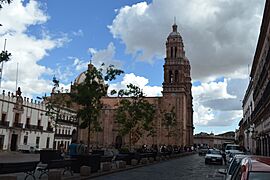
In the city center, just south of the main plaza, is the cathedral. It stands on the ruins of older temples. The current building was finished in 1752. Its front is made of sculpted pink stone. The best time to see it is in the late afternoon when the sun shines on it. This church is a great example of Mexican Churrigueresque architecture.
The first church on this spot was built between 1567 and 1585. But it was in ruins by the early 1600s. A second church was built from 1612 to 1625. The current cathedral started in 1729. Its main front was finished in 1745, but it opened in 1752.
The cathedral shows how rich the city was in the 1700s. Later, more parts were added. The dome was rebuilt in 1848. The south tower was finished in 1904. The church became a cathedral in 1862 and a national monument in 1935. In 1965, many valuable metal items were stolen from the building.
The cathedral is eighty-five meters tall and made of pink sandstone. It has three main entrances. The main front has three levels with columns and statues. The interior has a cross shape with two main aisles. The altars are made of stone in a Neoclassical style. The main altar is for the Eucharist.
Buildings and Plaza de Armas
The main square is called the Plaza de Armas. Important buildings like the State Government Palace and the cathedral surround it. The State Government Palace was built in the early 1700s as a home for a count. It has a red roof and a courtyard inside. A mural showing the state's history was painted there in 1970.
One mansion on the main plaza is the "Palacio de la Mala Noche." It belonged to a rich miner in the 1700s. The name means "Palace of the Bad Night." A story says the owner was about to give up when he found a new silver vein. Today, it houses the state supreme court. Another important mansion is the old house of González Ortega, next to the cathedral.
The Market
Next to the cathedral is the González Ortega Market. It was built in 1889 and still has its original look. It used to be a traditional market. Now, it is a modern mall with shops selling crafts, silver, leather, and local foods. You can find regional dishes like gorditas and enchiladas zacatecanas. The market has two floors with iron columns. Another craft market is the Casa de Artesanias, which sells wool blankets, masks, and ceramics.
Churches of Zacatecas
The former Temple of San Francisco was founded in 1568. It was the first monastery in Zacatecas, built to spread Christianity. It opened in 1707, but some parts were not finished until the 1800s. Today, the monastery is a museum, but the church is in ruins.
The church of St. Augustine (ex-templo de San Agustín) was built by the Augustinian religious order. They arrived in Zacatecas in 1575. The church was finished in 1617 and redone in 1782. After some time, it was sold and used as a pool hall and hotel. In 1882, it was sold again to a different group who removed its main front. The Catholic Church got it back in 1942. Now, only part of the monastery remains, housing the Rafael Coronel Museum.
The Temple of Santo Domingo was built by the Jesuits from 1746 to 1749. It is known as the Parish of the Inmaculada Concepción. The Dominicans took it over when the Jesuits left Mexico in the 1700s. It was used as the main church when the cathedral was being built. Inside, it has eight beautiful altars carved from wood and covered in gold from Cerro del Grillo. The Pedro Coronel Museum is attached to this church.
The Calderón Theater
The Calderón Theater was built after an earlier theater burned down in the 1880s. It has been open ever since, hosting famous performers. The building looks like a Renaissance revival style. It has a hall with large mirrors from Venice.
Other Interesting Places
There are many other interesting places in Zacatecas. The first city park is the Alameda Trinidad García de la Cadena, built in the early 1800s. The Enrique Estrada General Park has a huge kiosk. The Meson de Jobito is a 19th-century building near the garden for Benito Juárez. The former Bernárdez Hacienda is now a school for artisans who make silver items. Other mines you can visit include La Esperanza.
The Church of Nuestra Señora de Fátima is a rare example of Gothic architecture in Mexico. The Mauricio Magdaleno Public Library is in a 19th-century building that used to be a granary.
The former Plaza de Toros (bullring) and El Cubo aqueduct are near Cerro de la Bufa. The bullring opened in 1866 and still looks much like it did. Bullfighting events were held here. It closed in 1975 and was later turned into a hotel in 1989. The Hotel Quinta Real has 49 suites. Its hallways keep the bullring feel. The El Cubo aqueduct was built in the late 1700s to carry water from the El Cubo mine. Only a few arches remain.
Museums in Zacatecas
Zacatecas has many museums for its size.
The Pedro Coronel Museum is in the old monastery of the Santo Domingo church. This building also housed the Jesuit college of San Luis Gonzaga. This college was famous for its teaching. After the Jesuits left, the building was used as a barracks, prison, and warehouse. It was restored in 1981. The museum shows works by Zacatecas painter Pedro Coronel and art he collected. It has works by famous artists like Pablo Picasso and Dalí. There are also halls with art from Africa, India, Egypt, China, and Greece. The museum also has a large collection of old books.
The Rafael Coronel Museum, named after Pedro Coronel's brother, is in the San Francisco monastery. This museum focuses on historical items. Its main collection has 5,000 masks made of wood, leather, and clay from different Mexican cultures. Many masks show historical or magical figures. It also has drawings by Diego Rivera. There are also puppets from Burma, Indonesia, and China. This museum started when Rafael Coronel gave over 10,000 items from his collection to the city.
The Manuel Felguérez Museum has a large collection of abstract art by Manuel Felguérez and other artists. One exhibit shows "Murals of Osaka" created for the 1970 World's Fair. The museum building is from the 1700s. It used to be a seminary, then a barracks and prison. The museum opened in 1998.
The Zacatecano Museum is on Doctor Hierro Street. It has Huichol art, folk paintings (ex-votos), and ironwork. This building was a coin mint from 1802 to 1905. Other museums include the Episcopal Gallery, the Museo de la Ciencia (Science Museum), and the Francisco Goitia Museum. The Science Museum is in the old main building of the Universidad Autónoma de Zacatecas. It shows advances in physics, math, and natural sciences. The Francisco Goitia Museum has works by this Zacatecas artist and others.
Education in Zacatecas
Universities and Technical Schools
Zacatecas has several universities and higher education institutions. These include the state-run Universidad Autónoma de Zacatecas.
The Universidad Tecnológica del Estado de Zacatecas (UTEZ) is part of a national system of technical universities. It was founded in 1998 by the state government. It focuses on technology and business studies.
Other technical schools are the Instituto Tecnológico de Zacatecas, the Instituto Politécnico de Zacatecas, and a campus of the ITESM college system.
Festivals and Celebrations
The city hosts many religious and cultural festivals each year. The Festival Cultural de Zacatecas happens during Holy Week. It brings together artists of different styles, from classical to rock. It offers over 130 events, and about 90% are free.
The Feria Nacional de Zacatecas is held in September at the foot of Cerro de la Bufa. It includes concerts, bullfighting, craft shows, and livestock exhibits. This annual event started in 1940. It has hosted famous singers like Vicente Fernández and Alejandra Guzmán.
The Festival Zacatecas del Folclor International takes place in the first week of August.
Religious events include the feast of the Virgin of Zacatecas and the Virgin del Patrocinio. These events have parades, concerts, and religious ceremonies. The Virgin of Zacatecas is in a chapel built in 1728. The Virgin of Patrocinio's day is September 14. This event lasts ten days with traditional dances. It happens at the same time as the Feria Nacional de Zacatecas and Mexico's Independence Day. On Good Friday, a large "Procession of Silence" is held.
The last three days of August are for an event called Morismas de Bracho. About 5,000 people in costumes act out a battle between Christians and Moors. This event takes place at El Bracho Park, behind Cerro de la Bufa.
On June 23, the city remembers the Battle of Zacatecas at Cerro de la Bufa and the Plaza de Armas. There are cultural events and fireworks.
"Callejoneadas" are alleyway parties that can happen any time. These are traditional nightlife events where people dance, sing, and drink mezcal or a beer-based punch called "heribertas" for free. These parties often start in front of the Palacio de Gobierno. A band and a donkey carrying drinks gather, and then the party moves through the city's narrow streets. Most people are students, but everyone is welcome.
Zacatecas is home to a UNESCO office. This office helps with training, research, and saving artistic, historical, natural, and archaeological heritage in Mexico, Central America, and the Caribbean.
The city's chamber music festival has been held every year since 1993.
Transportation in Zacatecas
Zacatecas is connected by highways to cities like Aguascalientes, San Luis Potosí, and Guadalajara. A train line, the "Ferrocarril Central," still connects the city to places like Ciudad Juárez and Mexico City. The city has the General Leobardo C. Ruiz International Airport. It connects Zacatecas to Tijuana, Morelia, Leon, and Mexico City. Intercity buses connect the city to other regional and national places. There is also public transportation within the city.
The Municipality of Zacatecas
Geography of Zacatecas Municipality
The city of Zacatecas is the government center for 180 other small towns. The total area of the municipality is about 444 square kilometers. Most of the municipality's 132,035 people live in the city itself. There are almost no native communities in the municipality. Most people are "mestizo," meaning they have mixed indigenous and European backgrounds. A small number of people speak an indigenous language, but most also speak Spanish. The municipality borders Calera, Morelos, Vetagrande, Guadalupe, Genaro Codina, and Jerez.
The municipality is located between the Sierra Madre Occidental mountains and the Sierras y Valles Zacatecanos. The land is very rugged, with narrow valleys, ravines, and mountains. The main mountains include Cerro El Grillo at 2,690 meters and Cerro La Bufa at 2,650 meters. The area has many small streams.
Population of Zacatecas Municipality
The 2020 Mexican Census reported that Zacatecas municipality had a population of 149,607 people. Of these, 77,635 were female and 71,972 were male.
Climate in Zacatecas
Zacatecas City has a cold semi-arid climate. The average yearly temperature is 15.7°C. Freezing temperatures are common, especially in January and February. In the winter of 2017–2018, temperatures dropped to -12°C. Most rain falls between June and September.
The main wild plants are those that can live in dry areas. These include nopals, mesquite, maguey, and grasses. Pines and holm oaks grow in higher places. Wildlife includes coyotes, grey foxes, bobcats, opossums, rabbits, and raccoons. There are also many small birds and reptiles.
| Climate data for Zacatecas (Buenavista), elevation: 2352 m, 1991–2020 normals, extremes 1961–2018 | |||||||||||||
|---|---|---|---|---|---|---|---|---|---|---|---|---|---|
| Month | Jan | Feb | Mar | Apr | May | Jun | Jul | Aug | Sep | Oct | Nov | Dec | Year |
| Record high °C (°F) | 28.0 (82.4) |
29.0 (84.2) |
30.5 (86.9) |
34.0 (93.2) |
36.0 (96.8) |
36.0 (96.8) |
31.0 (87.8) |
29.9 (85.8) |
30.5 (86.9) |
30.0 (86.0) |
29.0 (84.2) |
28.0 (82.4) |
36.0 (96.8) |
| Mean daily maximum °C (°F) | 17.8 (64.0) |
20.1 (68.2) |
22.3 (72.1) |
24.7 (76.5) |
26.8 (80.2) |
25.6 (78.1) |
24.0 (75.2) |
24.0 (75.2) |
22.7 (72.9) |
22.1 (71.8) |
20.3 (68.5) |
18.3 (64.9) |
22.4 (72.3) |
| Daily mean °C (°F) | 11.7 (53.1) |
13.4 (56.1) |
15.3 (59.5) |
17.5 (63.5) |
19.6 (67.3) |
19.4 (66.9) |
18.0 (64.4) |
18.0 (64.4) |
17.2 (63.0) |
16.2 (61.2) |
14.1 (57.4) |
12.3 (54.1) |
16.1 (61.0) |
| Mean daily minimum °C (°F) | 5.6 (42.1) |
6.8 (44.2) |
8.2 (46.8) |
10.3 (50.5) |
12.5 (54.5) |
13.1 (55.6) |
12.0 (53.6) |
12.1 (53.8) |
11.6 (52.9) |
10.3 (50.5) |
7.8 (46.0) |
6.3 (43.3) |
9.7 (49.5) |
| Record low °C (°F) | −6.3 (20.7) |
−3.5 (25.7) |
−3.1 (26.4) |
3.0 (37.4) |
5.0 (41.0) |
8.0 (46.4) |
1.5 (34.7) |
5.0 (41.0) |
3.5 (38.3) |
2.0 (35.6) |
−3.5 (25.7) |
−11.0 (12.2) |
−11.0 (12.2) |
| Average precipitation mm (inches) | 18.5 (0.73) |
13.2 (0.52) |
9.5 (0.37) |
7.9 (0.31) |
19.8 (0.78) |
87.5 (3.44) |
106.3 (4.19) |
95.8 (3.77) |
96.1 (3.78) |
34.3 (1.35) |
15.1 (0.59) |
13.6 (0.54) |
517.6 (20.38) |
| Average precipitation days (≥ 0.1 mm) | 2.3 | 1.3 | 1.1 | 1.1 | 3.4 | 9.0 | 10.6 | 9.2 | 9.1 | 4.9 | 1.8 | 2.2 | 56.0 |
| Average snowy days | 0.33 | 0 | 0.03 | 0 | 0 | 0 | 0 | 0 | 0 | 0 | 0.46 | 0.11 | 0.93 |
| Source 1: Servicio Meteorologico Nacional | |||||||||||||
| Source 2: Colegio de Postgraduados (snow) | |||||||||||||
| Climate data for Zacatecas (La Bufa), elevation: 2576 m (1991–2020 normals, extremes 1951–2018) | |||||||||||||
|---|---|---|---|---|---|---|---|---|---|---|---|---|---|
| Month | Jan | Feb | Mar | Apr | May | Jun | Jul | Aug | Sep | Oct | Nov | Dec | Year |
| Record high °C (°F) | 29.0 (84.2) |
28.6 (83.5) |
29.8 (85.6) |
35.0 (95.0) |
34.8 (94.6) |
32.0 (89.6) |
31.0 (87.8) |
30.5 (86.9) |
29.4 (84.9) |
25.5 (77.9) |
27.9 (82.2) |
21.8 (71.2) |
35.0 (95.0) |
| Mean daily maximum °C (°F) | 15.2 (59.4) |
17.2 (63.0) |
18.8 (65.8) |
21.5 (70.7) |
23.3 (73.9) |
22.0 (71.6) |
20.5 (68.9) |
20.3 (68.5) |
19.0 (66.2) |
18.7 (65.7) |
17.3 (63.1) |
15.6 (60.1) |
19.1 (66.4) |
| Daily mean °C (°F) | 10.3 (50.5) |
11.9 (53.4) |
13.7 (56.7) |
15.9 (60.6) |
17.9 (64.2) |
17.0 (62.6) |
15.5 (59.9) |
15.3 (59.5) |
14.5 (58.1) |
14.1 (57.4) |
12.3 (54.1) |
11.0 (51.8) |
14.1 (57.4) |
| Mean daily minimum °C (°F) | 6.3 (43.3) |
7.5 (45.5) |
8.9 (48.0) |
11.0 (51.8) |
12.7 (54.9) |
12.4 (54.3) |
11.4 (52.5) |
11.5 (52.7) |
11.3 (52.3) |
10.6 (51.1) |
8.6 (47.5) |
7.4 (45.3) |
10.0 (50.0) |
| Record low °C (°F) | −14.0 (6.8) |
−9.2 (15.4) |
−4.2 (24.4) |
−1.6 (29.1) |
1.0 (33.8) |
1.4 (34.5) |
1.3 (34.3) |
1.0 (33.8) |
0.0 (32.0) |
1.0 (33.8) |
−5.1 (22.8) |
−12.2 (10.0) |
−14.0 (6.8) |
| Average precipitation mm (inches) | 12.1 (0.48) |
9.0 (0.35) |
4.0 (0.16) |
3.5 (0.14) |
12.0 (0.47) |
61.3 (2.41) |
94.0 (3.70) |
73.7 (2.90) |
73.7 (2.90) |
23.3 (0.92) |
9.1 (0.36) |
6.0 (0.24) |
381.5 (15.02) |
| Average precipitation days (≥ 1.0 mm) | 3.0 | 1.8 | 1.4 | 1.4 | 4.2 | 10.8 | 13.3 | 12.2 | 11.5 | 6.0 | 2.6 | 2.0 | 70.2 |
| Average relative humidity (%) | 46.7 | 41.6 | 34.2 | 31.0 | 37.8 | 57.3 | 67.4 | 67.8 | 72.7 | 61.0 | 52.7 | 47.6 | 51.5 |
| Mean monthly sunshine hours | 218.4 | 223.6 | 246.4 | 240.0 | 271.9 | 223.6 | 221.4 | 212.1 | 187.0 | 215.8 | 241.3 | 202.3 | 2,703.8 |
| Source 1: NOAA (sun 1961–1990) | |||||||||||||
| Source 2: Servicio Meteorologico Nacional (extremes) | |||||||||||||
Economy of Zacatecas Municipality
The most important parts of the local economy are mining, livestock, and trade. Mining employs about 21% of the people. Most mining today happens on the Panuco, Vetagrande, and Morelos mountains. The most active mines are El Compas and San Rafael. They produce gold, silver, and lead.
About 76% of the land is used for raising animals. Only 15% of the land is farmed. This farming depends on the yearly rainy season. It produces basic foods like beans, chili peppers, and corn. Livestock includes cattle, pigs, sheep, goats, and horses.
There is also some industry related to food, textiles, wood, paper, and mining equipment. People also make crafts like blankets, stonework, and silver items. Trade serves local needs and tourism. Besides being a World Heritage site, there is camping in the Sierra de Organos. La Quemada is the most famous archaeological site in Zacatecas. Its artifacts show influences from other cultures like Teotihuacan.
Sports in Zacatecas
| Club | Sport | Founded | League |
|---|---|---|---|
| Mineros de Zacatecas (basketball) | Basketball | 2017 | LNBP |
| Mineros de Zacatecas | Football | 2014 | Ascenso MX |
| Tuzos de la UAZ | Football | 2006 | Serie A |
Sister Cities
Zacatecas has these sister cities:
- Azusa, California, United States
- El Paso, Texas, United States
- Málaga, Andalusia, Spain
- Santa Fe, New Mexico, United States
- Wichita, Kansas, United States
- Norwalk, California, United States
- Hanover Township, Illinois, United States
- Memphis, Tennessee, United States
- Woodstock, Illinois, United States
See also
 In Spanish: Zacatecas (Zacatecas) para niños
In Spanish: Zacatecas (Zacatecas) para niños









